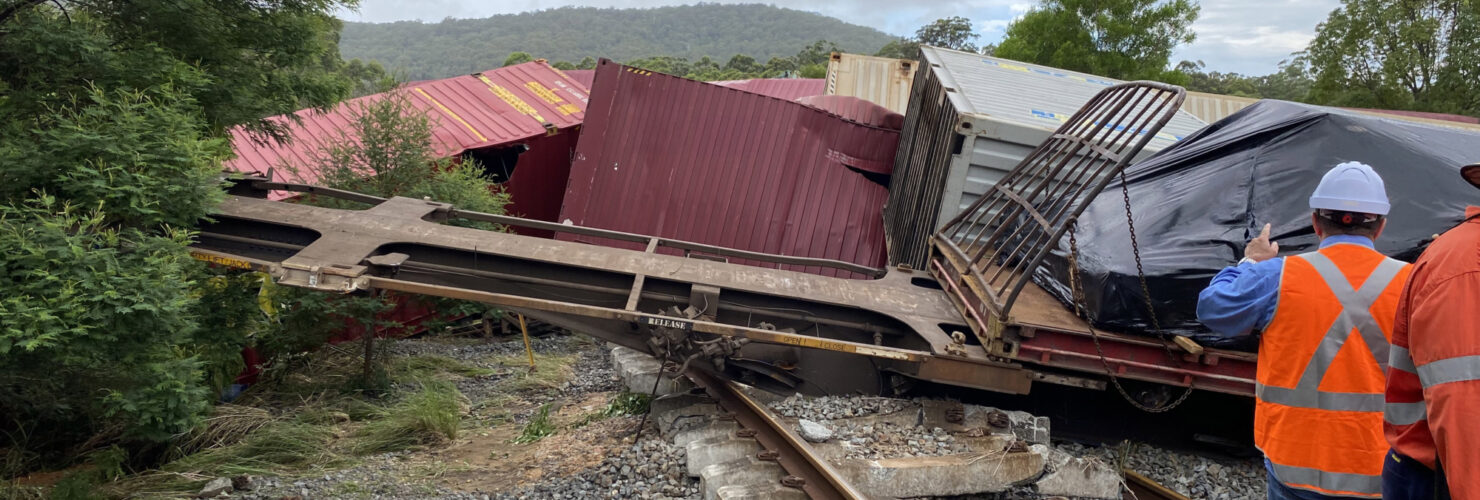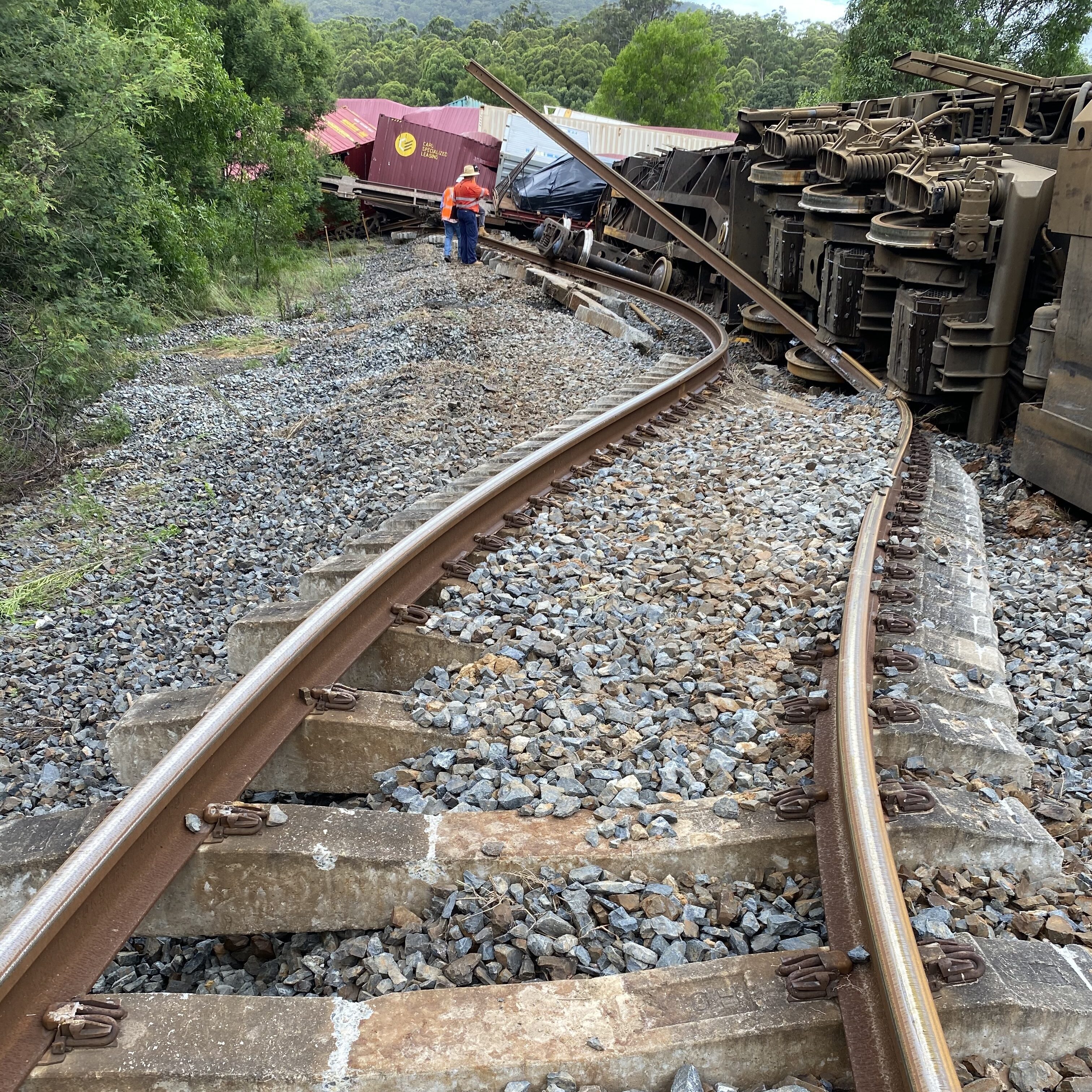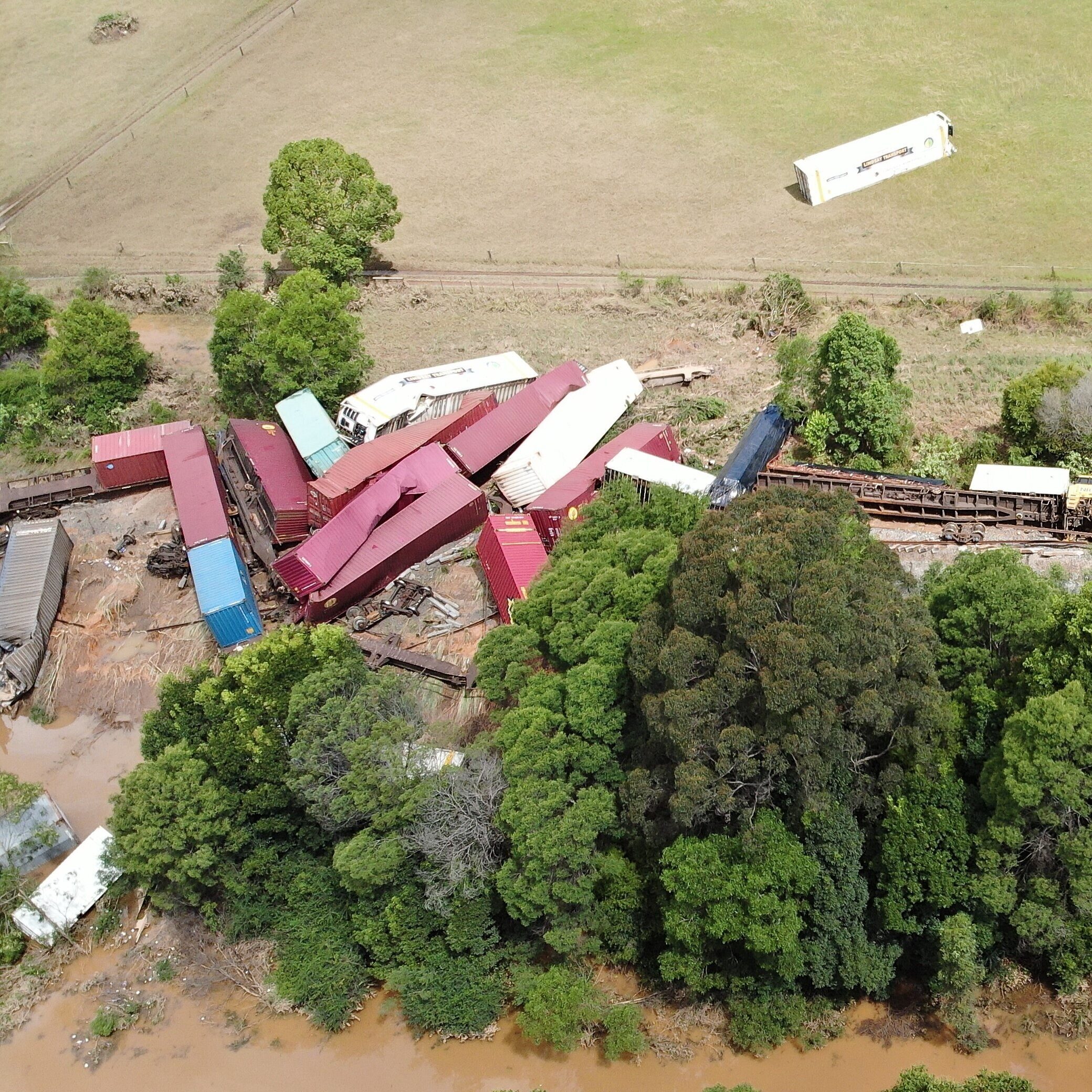Tuesday, June 10, 2025
Nana Glen - 25/02/2021 - A Case Study
At around 1:30am 25 February 2021, a Pacific National freight train consisting of three locomotives and almost 40 wagons, including some carrying dangerous goods, derailed at Nana Glen, 600 km north of Sydney. One train driver sustained minor injuries, and rolling stock, freight and a large section of railway were damaged.

At A Glance
WHAT HAPPENED?
At around 1:30am 25 February 2021, a Pacific National freight train consisting of three locomotives and almost 40 wagons, including some carrying dangerous goods, derailed at Nana Glen, 600 km north of Sydney. One train driver sustained minor injuries, and rolling stock, freight and a large section of railway were damaged.
WHY?
Limitations in the rail infrastructure manager’s Safety Management System (SMS) meant that the extent of flood risk associated with unprecedented extreme weather was not identified. The situation was exacerbated by insufficient culvert capacity that collectively exposed the train and its crew to a section of track that had been washed away by floodwaters.
ONRSR DRIVEN SAFETY IMPROVEMENT
- Establishment of ARTC Extreme Weather Improvement Program


The Investigation
ONRSR’s investigation into the derailment began on the morning of the incident when a temporary Non-Disturbance Notice was served on the rail infrastructure manager, Australian Rail Track Corporation (ARTC) and the rolling tock operator, Pacific National, respectively. This enabled a site inspection by investigators and a track and civil engineering specialist which soon confirmed the washaway of around 100 m of ballast under the mainline. The team also noted silt deposited on surrounding vegetation that indicated water had risen to approximately 10 m above normal levels around the time of the derailment.
Between 24 and 25 February, Nana Glen recorded more than 310 mm of rain – most of which had fallen in a concentrated 6-hour period. This was the highest ever recorded rainfall at this location.
ONRSR investigators found that while ARTC received at least two “Amber” alerts warning of the potential for flash flooding in the area, they did not mobilise their own Extreme Weather Group as it was contingent on “Red” or “Black” forecasts. Similarly, the “Amber” alerts didn’t require ARTC to notify operators like Pacific National of the imminent danger or undertake additional inspections of the track. Investigators noted that all three of these measures were included in the ARTC Safety Management System and detailed via the Monitoring and Responding to Extreme Weather Events operating procedure. Section 1.4 of the procedure – Definitions – documented an extreme weather event as: ‘Any event including but not limited to floods, electrical storms, and damaging winds which demonstrate potential to impact on the ARTC rail network and the organisation’s operations.’ However, the unprecedented nature of the extreme weather far exceeded the forecasts received by ARTC.
The investigation found that while the alerts ARTC received through its own weather monitoring service did not forecast conditions of the severity of those that eventuated, it was also provided with Bureau of Meteorology warnings of high risk for flash flooding, but they did not appear to show that the rail line would be affected by the weather event. While the Bureau of Meteorology subsequently issued further severe thunderstorm warnings over a larger portion of the north coast and that could impact the rail line, ARTC’s monitoring service did not pass those on to ARTC.
In any case, a lack of clarity in procedures and process about what level of warning should be the trigger for mobilising the Extreme Weather Group and insufficiencies in the collection of data to identify, monitor and respond to flooding risk ultimately compromised the effectiveness of the Safety Management System.
In all some 140 metres of mainline would have to be reinstated at a cost of more than $1 million with the section of track out of action for almost 10 days. The costs associated with rolling stock damage and recovery topped $5 million.
Safey Improvement
ONRSR has a range of compliance powers at its disposal in the event of incidents such as this one. While legislative sanctions and enforcement options were available, a key consideration in reaching an outcome is to assess where ONRSR can deliver the greatest rail safety benefit. The opportunity to deliver a more holistic and timely industry outcome is always weighed up against the costs and time associated with securing compliance through legal avenues.
Initially, ONRSR worked with the ARTC to address the need for greater understanding of those locations around its vast network that were more prone to, or had a history of, flooding. This work resulted in a positive and timely rail safety outcome via the creation of a register of sites subject to flood risk that was subsequently supported by operational procedures that would allow for ARTC to take appropriate action when extreme weather events occur in the future.
Following completion of this initial step, ONRSR and ARTC remained focused on broader improvements to ARTC’s safety management system and the need to improve its system to recognise the realities of climate change. There was a clear need for ARTC, other rail infrastructure managers, and rail transport operators to factor the increasing prevalence and severity of extreme weather events into their risk management processes.
Subsequently, ONRSR continued to work with ARTC to oversee its development of a strategy for identifying and managing the risks to rail safety associated with extreme weather. Ultimately, these discussions led to the creation of the ARTC Extreme Weather Improvement Program (EWIP) consisting of a series of work activities, each with documented objectives, key performance indicators and completion dates.
Headlined by a full review of climate change, and internal understanding of its impacts on the ARTC network, and backed by a comprehensive change management plan, EWIP is facilitating real-time responses to future events. The multi-faceted program incorporates improvements to communication with drivers and other rail safety workers, the procurement of state-of-the-art monitoring devices, development of new ARTC extreme weather procedures, a review of new and emerging technology and the use of trend analysis for reporting.
Specifically, through the implementation of the EWIP, ARTC has delivered 12 key initiatives including:
- completion of hydrology assessment of the entire network identifying theoretical hydraulic capacity of all structures, enabling data-driven infrastructure maintenance and flood risk management decisions
- installation of additional remote weather stations with water height monitors providing comprehensive weather monitoring and early flood warning across critical network sections
- engagement of a new weather monitoring provider delivering real-time weather alerts and location specific flood warnings to ARTC’s control centres and field teams
- the development of an enterprise-wide special locations register within its asset management system, centralising flood-prone location data for systematic monitoring and proactive maintenance planning
- implementation of a seven-day weather forecast system enabling advance planning for weather disruptions and coordinated service management.
The nation’s largest rail infrastructure manager now has access to more detailed flood modelling and a documented flood study of its network that can advise on infrastructure works and inform maintenance schedules. There is also dedicated guidance for train drivers on extreme weather events and effective communication with other RIMs to facilitate information sharing on approaches to climate change and extreme weather risk.
The EWIP’s development and implementation has been closely monitored and documented by ONRSR every step of the way to ensure it represents the best possible outcome in response to the Nana Glen derailment and that it provides a practical example of vastly improved practice when it comes to managing rail safety risk.
ONRSR’s Reflections
ONRSR’s General Manager, South Australia, Ewald Eisele, whose team oversaw the national regulator’s supervision and monitoring of the EWIP’s development, said the project represented a very positive rail safety outcome not just for the ARTC but for the whole industry.
“The incident at Nana Glen was a really serious one and it was really only luck that the rail safety workers weren’t seriously hurt.”
“It was vitally important that lessons were learned from it and that these are seen and heard across industry – chief among them is the need to be much better prepared for and able to identify and respond to extreme weather events that impact rail operations and safety.”
“As clearly demonstrated by the droughts and flooding rains that have affected parts of Australia in 2025, the problems of climate change are undeniably upon us with a severity and frequency the likes of which we have not seen to date and addressing them will be a test of our resilience and ingenuity.”
“Resources like an EWIP are an integral part of the frontline response, and the national regulator will be playing its part in spreading word about the need for operators to bolster their safety management systems to ensure the risks associated with extreme weather are being managed SFAIRP.”
FINAL NOTE:
It is a legislative requirement of accreditation that rail transport operators have an appropriate safety management system in place.
Such systems are rail transport operators’ primary means for identifying hazards, recording the risks to safety identified within operations and detailing how those risks are managed and monitored. Operators are legally obliged to implement and then comply with their SMS.
For further information visit: Safety management systems | ONRSR
Separate to ONRSR’s regulatory investigation, the Nana Glen derailment was also the subject of an Australian Transport Safety Bureau (ATSB) ‘no-blame’ investigation, conducted for the ATSB by the Office of Transport Safety Investigations in NSW. No-blame investigations aim to prevent future incidents by ensuring lessons are learned and safety improvements are made by the relevant parties including rail infrastructure managers, rolling stock operators, government agencies and regulators. See the ATSB report: Derailment of freight train 4BM4, Nana Glen, New South Wales, on 25 February 2021.